#pinckney benton pinchback
Text
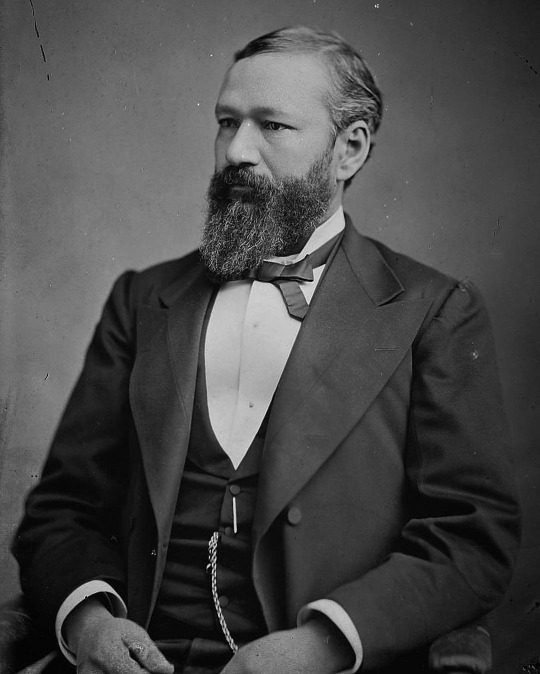
Today In History
Pinckney Benton Steward Pinchback (P.B.S.), was an American publisher, advocate for education, politician, and Union Army officer born in Macon, GA, on this date May 10, 1837.
Pinchback was the first African American to serve as governor of a U.S. state (Louisiana) and the second African American to serve as lieutenant governor of a U.S. state.
He held office for only 35 days, but ten acts of the Legislature became law during that time.
After William Pitt Kellogg took office as a result of the controversial election of 1872, Pinchback continued his career, holding various offices including a seat on the State Board of Education, Internal Revenue agent and as a member of the Board of Trustees of Southern University.
Pinchback helped establish Southern University when, in the Constitutional Convention of 1879, he pushed for the creation of a college for blacks in Louisiana.
Pinchback and his family moved to Washington and then New York where he was a Federal Marshal. He later moved back to Washington to practice law and died there in 1921. Pinchback is buried in Metairie.
CARTER™️ Magazine carter-mag.com #wherehistoryandhiphopmeet #historyandhiphop365 #cartermagazine #carter #staywoke #pinckneybentonstewart #pbs #blackhistorymonth #blackhistory #history
#pinckney benton pinchback#carter magazine#carter#historyandhiphop365#wherehistoryandhiphopmeet#history#cartermagazine#today in history#staywoke#blackhistory#blackhistorymonth
29 notes
·
View notes
Text
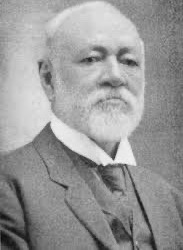
Governor Pinckney Benton Stewart Pinchback (born Pinckney Benton Stewart, May 10, 1837 – December 21, 1921) was a publisher and politician, a Union Army officer, and the first African American to become governor of a US state. A Republican, he served as the 24th Governor of Louisiana (December 9, 1872 - January 13, 1873). He was one of the most prominent African-American officeholders during the Reconstruction Era.
He traveled to Union-occupied New Orleans. There he raised several companies for the 1st LA Native Guard and became one of the few African Americans commissioned as officers in the Union Army.
He remained in New Orleans after the Civil War, becoming active in Republican politics. He won election to LA State Senate in 1868 and became the president pro tempore of the state senate. He became the acting Lieutenant Governor of LA upon the death of Oscar Dunn in 1871 and served as Governor of LA after Henry C. Warmoth was suspended from office. He was the first African American to serve as a US governor. African Americans were increasingly disenfranchised in the South at the turn of the 20th century; he was the only African American to serve as governor of a US state until 1890. After the contested 1872 Louisiana gubernatorial election, Republican legislators elected Pinchback to the Senate. Due to the controversy over the 1872 elections in the state, which were challenged by white Democrats, he was never seated in Congress.
He served as a delegate to the 1879 Louisiana Constitutional Convention, where he helped gain support for the founding of Southern University. In a Republican federal appointment, he served as the surveyor of US customs of New Orleans. He worked with other leading men of color to challenge the segregation of Louisiana’s public transportation system, leading to the SCOTUS case of Plessy v. Ferguson. To escape increasing racial oppression, he moved with his family to DC, where they were among the elite people of color. #africanhistory365 #africanexcellence
0 notes
Photo
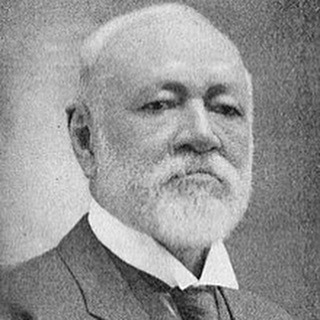
Pinckney Benton Stewart Pinchback (born Pinckney Benton Stewart, May 10, 1837 – December 21, 1921) was an American publisher and politician, a Union Army officer, and the first African American to become governor of a U.S. state. A Republican, Pinchback served as the 24th Governor of Louisiana from December 9, 1872, to January 13, 1873. He was one of the most prominent African-American officeholders during the Reconstruction Era. African Americans were increasingly disenfranchised in the South at the turn of the 20th century; Pinchback was the only African American to serve as governor of a U.S. state until Douglas Wilder became governor of Virginia in 1990. After the contested 1872 Louisiana gubernatorial election, Republican legislators elected Pinchback to the United States Senate. Due to the controversy over the 1872 elections in the state, which were challenged by white Democrats, Pinchback was never seated in Congress. Pinchback served as a delegate to the 1879 Louisiana constitutional convention, where he helped gain support for the founding of Southern University. #pinckneybentonstewartpinchback #pinckneybentonstewart #blackhistoryunlocked https://www.instagram.com/p/CLQGhZ6hsYs/?igshid=1l6bk87lv4c2u
0 notes
Text
P. B. S. Pinchback
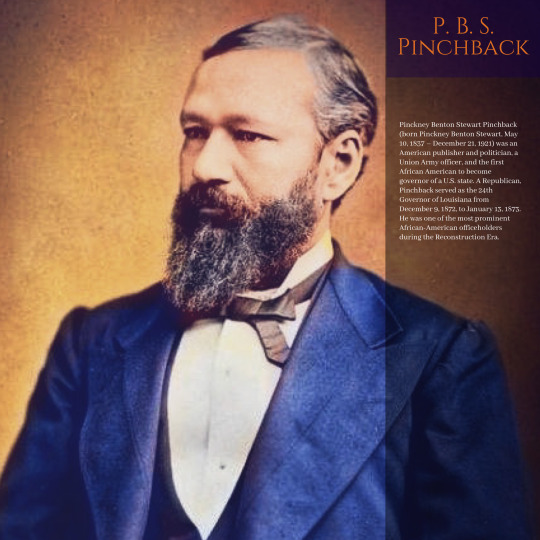
Pinckney Benton Stewart Pinchback (born Pinckney Benton Stewart, May 10, 1837 – December 21, 1921) was an American publisher and politician, a Union Army officer, and the first African American to become governor of a U.S. state. A Republican, Pinchback served as the 24th Governor of Louisiana from December 9, 1872, to January 13, 1873. He was one of the most prominent African-American officeholders during the Reconstruction Era.
Pinchback was born free in Macon, Georgia to Eliza Stewart, a freed mulatto woman, and William Pinchback, a white planter. His father raised the younger Pinchback and his siblings as his own children on his large plantation in Mississippi. After the death of his father in 1848, his mother took Pinchback and siblings to the free state of Ohio to ensure their continued freedom. After the start of the American Civil War, Pinchback traveled to Union-occupied New Orleans. There he raised several companies for the 1st Louisiana Native Guard, and became one of the few African Americans commissioned as officers in the Union Army.
Pinchback remained in New Orleans after the Civil War, becoming active in Republican politics. He won election to the Louisiana State Senate in 1868 and became the president pro tempore of the state senate. He became the acting Lieutenant Governor of Louisiana upon the death of Oscar Dunn in 1871 and briefly served as Governor of Louisiana after Henry C. Warmoth was suspended from office. He was the first African American to serve as a US governor. African Americans were increasingly disenfranchised in the South at the turn of the 20th century; Pinchback was the only African American to serve as governor of a U.S. state until L. Douglas Wilder became governor of Virginia in 1990. After the contested 1872 Louisiana gubernatorial election, Republican legislators elected Pinchback to the United States Senate. Due to the controversy over the 1872 elections in the state, which were challenged by white Democrats, Pinchback was never seated in Congress.
Pinchback served as a delegate to the 1879 Louisiana constitutional convention, where he helped gain support for the founding of Southern University. In a Republican federal appointment, he served as the surveyor of US customs of New Orleans from 1882 to 1885. Later he worked with other leading men of color to challenge the segregation of Louisiana's public transportation system, leading to the Supreme Court case of Plessy v. Ferguson. To escape increasing racial oppression, he moved with his family to Washington, D.C. in 1892, where they were among the elite people of color. He died there in 1921.
Early life
He was born free as Pinckney Benton Stewart in May 1837 in Macon, Bibb County, Georgia. His parents were Eliza Stewart, a former slave, and Major William Pinchback, a white planter and his mother's former master. William Pinchback, who also had a legal white family, freed Eliza and her two surviving children in 1836; she had borne six by that point and two had survived. She had four more children with Pinchback, all born into freedom under Georgia law because she was free.
Pinckney Stewart's parents were of diverse ethnic origins; Eliza Stewart was classified as mulatto (mixed race), and had known African, Cherokee, Welsh, and German ancestry. William Pinchback was ethnic European-American, of Scots-Irish, Welsh, and German American ancestry. Their mixed-race children were of majority European-American ancestry. Shortly after Pinckney's birth, his father William purchased a much larger plantation in Mississippi, and he moved there with both his white and mixed-race families.
Pinckney Benton Stewart and his siblings were considered the "natural" (or illegitimate) children of their father, but they were brought up in relatively affluent surroundings. He treated them as his own, with privileges similar to the white children on his plantation. In 1846, Pinchback sent the 9-year-old Pinckney and his older brother Napoleon north for education at a private academy, Gilmore High School in Cincinnati, Ohio. In 1848, when Pinckney was eleven, his father died.
Fearful that the other Pinchback relatives might try to claim her children as slaves, Eliza Stewart fled with the children to Cincinnati in the free state of Ohio. Napoleon, at 18, helped to keep the family together but broke down under the responsibility. At 12, Pinckney left school and began to work as a cabin boy on river and canal boats to help his family. For a while he lived in Terre Haute, Indiana, where he worked as a hotel porter. During that time, he still identified as Pinckney B. Stewart. He did not take his father's surname of Pinchback until after the end of the Civil War.
Marriage and family
In 1860 at the age of 23, Stewart married Emily Hawthorne, a free woman of color. Like Stewart, she was "practically white" in appearance, meaning she had a high proportion of European ancestors. They had four children: Pinckney Napoleon in 1862, Bismarck in 1864, Nina in 1866, and Walter Alexander in 1868. Two others had died young. Pinckney named one son Bismarck because of his admiration for statesman Otto von Bismarck of Germany, whom he considered to be one of the world's greatest men. Pinckney's mother Eliza Stewart lived with Pinchback and his family from 1867 to her death in 1884.
They had a fine house in New Orleans. Usually, in the summer, the whole family traveled to Saratoga Springs, New York, a resort town in upstate, where they would stay for several weeks. Pinchback liked to gamble on the horse racing held there during the summer season.
Military service and Civil War
The Civil War began the following year, and Stewart decided to fight on the side of the Union. In 1862, he made his way to New Orleans, which had just been captured by the Union Army. He raised several companies for the Union's all-black 1st Louisiana Native Guards Regiment, which was garrisoned in the city. A minority of the men were Louisiana free men of color, part of the educated class before the war who had participated in the state militia. Most of the Guards were former slaves, who had escaped to join the Union forces and gain freedom.
Commissioned a captain, Stewart was one of the Union Army's few commissioned officers of African-American ancestry. Like Stewart, the officers were mostly of mixed race. Most of them were drawn from the class of free people of color in New Orleans established before the war; unlike him, they were usually of colonial French and African descent. He became Company Commander of Company A, 2nd Louisiana Regiment Native Guard Infantry, made up mostly of refugee slaves. (It was later reformed as the 74th US Colored Infantry Regiment, of the United States Colored Troops.)
Passed over twice for promotion and tired of the prejudice he encountered from white officers, Stewart resigned his commission in 1863. In a letter of April 30, 1863, his married sister Adeline B. Saffold wrote to him from Sidney, Ohio, urging him to follow her example and enter the white world:
If I were you, Pink, I would not let my ambition die. I would seek to rise and not in that class either but I would take my position in the world as a white man as you are and let the other go for be assured of this as the other you will never get your rights. ...
After the war, Stewart and his wife moved to Alabama.
Political career
After the war in New Orleans, Stewart took his father's surname of Pinchback. He became active in the Republican Party. The exact moment Pinchback decided to enter politics is described by George Devol in his book Forty Years a Gambler on the Mississippi. In 1867, Pinchback organized the Fourth Ward Republican Club in New Orleans soon after Congress passed the Reconstruction Acts. That year, he was elected as a delegate to the constitutional convention.
In 1868 Pinchback was elected as a State Senator. He was elected as senate president pro tempore; seven of 36 seats in the Senate were held by men of color. The House had 42 representatives of African-American descent, comprising half the seats. (At the time, the populations of African Americans, including former free people of color, and whites in the state were nearly equal.)
As Senate president pro tempore, in 1871 Pinchback succeeded to the position as acting lieutenant governor upon the death of Oscar Dunn, the first elected African-American lieutenant governor of a US state.
Pinchback contributed further to the political discussion after acquiring the biweekly newspaper, the New Orleans Louisianian. He published the paper until 1879.
He was appointed as director of the New Orleans public schools. Statewide public schools were established for the first time by the new state legislature during Reconstruction. Pinchback had a long-standing interest in education of blacks and was appointed to the Louisiana State Board of Education, where he served from March 18, 1871 until March, 1877.
In 1872, the legislature filed impeachment charges against the incumbent Republican governor, Henry Clay Warmoth, over disputes over certifying returns of the disputed gubernatorial election, in which both Democrat John McEnery and Republican William Kellogg claimed victory. Trying to support a centrist fusion government at a time of divisions among Republicans, Warmoth had supported his appointed return board, which certified McEnery as winner. Republicans opposed this outcome and appointed their own returns board, which certified Kellogg. The election had been marked by violence and fraud. State law required Warmoth to step aside until his impeachment case was tried. Pinchback took the oath as acting governor on December 9, 1872, and he served for about six weeks, until the end of Warmoth's term. Warmoth was not convicted, and the charges were eventually dropped by the legislature.
Also in 1872, at a national convention of African-American politicians, Pinchback had a public disagreement with Jeremiah Haralson of Alabama. James T. Rapier, also of Alabama, submitted a motion that the convention condemn all Republicans who had opposed President Ulysses S. Grant in that year's election. Haralson supported the motion, but Pinchback opposed it because Senator Charles Sumner of Massachusetts would have been condemned for opposing Grant. Pinchback admired Sumner as a lifelong anti-slavery fighter.
1870s congressional elections
After his brief governorship, Pinchback remained active in politics and public service in Louisiana. From 1868, campaigns and elections in Louisiana were increasingly marked by Democratic violence. Historian George C. Rable described the White League, a paramilitary group started in 1874, as the "military arm of the Democratic Party." The paramilitary group used intimidation and violence to suppress black voting and run Republicans out of office.
As an outcome of the controversial 1872 election, four US seats from Louisiana were also contested, including Pinchback's seat in the at-large position. He was the first African American elected to Congress from Louisiana. In early 1873, both the Republican William Kellogg-allied state legislators, who had a slight majority, and the Democrat John McEnery-allied legislators elected US Senators. Pinchback was elected by the Republicans and presented the Senate with his credentials. The Democratic candidate also presented credentials. As the 1872 gubernatorial contest had involved the national government, Congress was initially reluctant to assess these issues. The contested claim was not settled for years, at a time when Democrats controlled Congress.
Holding out for the Senate seat, Pinchback conceded the House seat to his Democratic opponent. The 45th Congress (1877–1879), which finally decided the issue, had a Democratic majority and voted against Pinchback. The Senate awarded him compensation of $16,000 for his salary and mileage after his protracted struggle to take his seat.
In his memoir of Reconstruction, former Louisiana governor Henry Clay Warmoth wrote that the federal government was reluctant to seat people representing the Kellogg-Pinchback faction. He had a personal interest, as he had been forced out of Louisiana after allying with white conservatives in the 1872 election certification. Historian John C. Rodrigue notes that the Committee on Elections was dealing with its own internal issues. It had accepted Pinchback's claim to the House seat, but he was holding out for the Senate seat. Complications arose after the Democrats took control of the next Congress and upheld election of his opponent.
Overall, the mid- to late 1870s marked an acceleration of the reversal of the political gains that African Americans in Louisiana had achieved since the end of the Civil War. In 1877, Democrats fully regained control of the state legislature after the withdrawal of federal troops, as a result of a national Democratic compromise marking the end of Reconstruction. Republican blacks continued to be elected to state and local offices, but elections were accompanied by violence and fraud. Most blacks were totally disfranchised by a new state constitution in 1898 and were effectively excluded from politics for decades.
Pinchback served as a delegate to the 1879 state constitutional convention; he and two other Republican African-American delegates, Theophile T. Allain, and Henry Demas, were credited with gaining support to establish Southern University, a historically black college in New Orleans, which was chartered in 1880. Pinchback was appointed as a member of Southern University's Board of Trustees (later redesignated the Board of Supervisors). The college relocated to the capital, Baton Rouge, in 1914. He was a delegate to the 1880 Republican National Convention.
In 1882, the national Republican administration appointed Pinchback as surveyor of customs in New Orleans, a politically significant position in which he served until 1885. It was his last political position.
Later life
In 1885, Pinchback studied law in New Orleans at Straight University, a historically black college later known as Dillard University. He was admitted to the Louisiana bar in 1886, but never practiced.
Continuing to be active in the African-American community, Pinchback had joined the Comité des Citoyens (Citizens' Committee), which set up the New Orleans civil rights challenge of Homer Plessy to state segregation in public transportation. Interstate trains were covered by federal legislation and supposed to be integrated. The case went to the Supreme Court of the United States as Plessy v. Ferguson. The Court ruled in 1896 that the state's providing "separate but equal" accommodations to African Americans was constitutional. This was a setback for African Americans; in practice, white-dominated legislatures and authorities generally underfunded black facilities, from train cars and waiting rooms to everything else.
Pinchback moved with his family to Washington, D.C., in 1892. Wealthy from his positions and settlement on the Senate seat, he had a large mansion built off Fourteenth Street near the Chinese embassy. At the time, his oldest son, Pinckney Pinchback, was established as a pharmacist in Philadelphia; the younger three ranged in age from 26 to 22 and were still living at home. The Pinchback family was part of the mixed-race elite in Washington; people in the group had generally been free before the war and often were educated and had acquired property. The Washington Post covered Pinchback's housewarming reception and his many high-ranking guests.
Later, Pinchback worked for a time in New York as a US Marshal.
By his death in 1921 in Washington, D.C., Pinchback was little known politically. His body was returned to New Orleans, where he was interred in Metairie Cemetery.
Legacy
Pinchback and his wife Nina were the maternal grandparents of Jean Toomer. Their daughter Nina Pinchback Toomer returned to live with her parents after her husband abandoned her and Jean as an infant. They helped raise him, and he started school in Washington, D.C.. After his mother remarried, they moved to New Rochelle, New York. He returned to his grandparents after his mother died in 1909, and went to high school at the academic M Street School. As an adult, Toomer became a poet and writer who was prominent as a modernist in New York during the Harlem Renaissance.
It was not until 1990 that another African American served as governor of any U.S. state. In 1989, Douglas Wilder of Virginia became the first to be elected to office (and the second African-American state governor). Deval Patrick of Massachusetts was elected governor in 2006 and served from January 2007 to January 2015. David Paterson of New York became the fourth African-American governor on March 17, 2008, when he succeeded to office following the resignation of Eliot Spitzer.
1 note
·
View note
Text
How Stacey Abrams' 'black girl magic' turned Georgia a bit more blue
http://bit.ly/2s84Lfa
Abrams savors her victory. AP Photo/John Bazemore
On May 22, 2018, Stacey Abrams, an African-American, 44-year-old former attorney, Georgia General Assembly House minority leader and Yale Law graduate beat former attorney white Georgia state legislator Stacey Evans in the Georgia Democratic gubernatorial primary. While the race was hard-fought, the outcome was lopsided with Abrams winning 423,163 (76.5 percent) votes over Evans’ 130,234.
As a professor of political science and African-American studies, I was very interested in this election’s outcome. Although African-Americans and women participate frequently in the political process, few people from these groups win elections - especially at the statewide level.
Although Georgia is known for infamous, segregationist governors like Lester Maddox, this campaign which pitted a white woman against a black woman was largely absent of overt racial appeals. The campaigns of both women appealed to liberals and moderates. Evans’ campaign strategy heavily focused on building a coalition among African-Americans, Latinos, women, youth and other progressives by emphasizing issues such as educational and job opportunities, voting rights and an end to crime.
Abrams campaign platform was remarkably similar, but she also emphasized the need for LGBTQ rights, energy jobs, veterans’ rights and small business development. Abrams benefited from the “linked fate” philosophy among African-Americans that influences them to prefer black candidates because of their interests in advancing their individual and group interests. She also had more experience registering voters than Evans did, after having served as the director of the New Georgia Project that registered thousands of black, Latino and Asian-American Georgia residents who usually don’t vote.
History in the making?
This “battle of the two Staceys” was historic because two women competed as major contenders in a Georgia gubernatorial primary for the first time in its history.
Abrams becomes the first female nominee and the first black nominee of a major party for a Georgia governor’s race. If she wins in November, her victory will add to the small number of women who have served as state governors, the even smaller number of African-Americans, and she will become the first black female governor of any American state.
There have only been four black governors in American history. In 1872, Pinckney Benton Stewart Pinchback, a Republican, served as Louisiana governor for 34 days while incumbent governor, Henry Warmoth, faced impeachment.
The other African-American governors were Democrats. More than 100 years after Pinchback served, Virginia Gov. L. Douglas Wilder became the first black elected governor of a state in 1989 and served for one term. The others were Deval Patrick of Massachusetts and David Paterson of New York.
Nearly half of American states have never had a female governor. Forty-six women are running for governor this year, which is much more than the previous record of 34 female gubernatorial candidates in 1994.
Black girl magic
So, what does Abrams need to do to win?
First, she needs to shore up her support among Democrats by encouraging a high turnout. Early Democratic primary turnout results indicate that the Democratic turnout is higher in this year’s primary than the primaries of four years ago. In 2014 and 2016, Republican turnout averaged about 61 percent and Democrats about 37 percent in early and absentee votes. This year the Republican turnout rate decreased to 53 percent while Democratic turnout increased to 46 percent.
Black voters can make or break Abrams’ victory. Their numbers have grown steadily over the last few decades. For example, in 1990, 27 percent of the state’s population was African-American. That percentage grew to 32 percent in 2016.
Abrams must find a way to motivate black voters into turning out on Election Day, while also winning as many white and Hispanic votes as possible. This won’t be easy. Black turnout has steadily declined in Georgia during the post-Obama years. In 2016, black turnout declined to 59 percent from a high of 66 percent in 2012. During the 2014 midterm elections, only 41 percent of black registered voters participated in the state’s elections.
In particular, Abrams must take advantage of the power of the black female swing vote. “Black girl magic” is the term used to describe black female beauty, intellect and empowerment. African-American women have emerged as a solid bloc of reliable voters for the Democratic candidates they favor. In 2016, 94 percent of them voted for Hillary Clinton, while 53 percent of white women supported Trump.
In the 2017 Alabama U.S. Senate race, the 98 percent black female vote for Doug Jones tipped the scales of the election in his favor and allowed him to defeat Roy Moore.
The key question that remains after the euphoria over the historic significance of having a serious black female contender for governor is, “What does this mean for Donald Trump?” If Georgia elects a black female governor who has the ability to mobilize black, female, progressive, young and other minority voters, will it tip Georgia’s scales from the red side to the blue side?
Sharon Austin does not work for, consult, own shares in or receive funding from any company or organization that would benefit from this article, and has disclosed no relevant affiliations beyond their academic appointment.
0 notes
Text
Reconstructing Pinchback: The Story of Gov. P.B.S. Pinchback
[ad_1]
Elizabeth Lilly Stewart was a graduate student when Dr. Joe Gray Taylor, Chairman of the History Department at McNeese State University, asked her to write a review for a scholarly journal of a prominent Historian’s newest offering. The book she was to review, and criticize if necessary, was the first and only biography ever written of Pinckney Benton Stewart Pinchback, Reconstruction…
View On WordPress
1 note
·
View note
Text

Today In History
Pinckney Benton Steward Pinchback (P.B.S.), was an American publisher, politician, and Union Army officer born in Macon, GA, on this date May 10, 1837.
Pinchback was the first African American to serve as governor of a U.S. state and the second African American to serve as lieutenant governor of a U.S. state.
CARTER™️ Magazine carter-mag.com #wherehistoryandhiphopmeet #historyandhiphop365 #cartermagazine #carter #staywoke #pinckneybentonstewart #pbs #blackhistorymonth #blackhistory #history
#carter magazine#carter#historyandhiphop365#wherehistoryandhiphopmeet#history#cartermagazine#today in history#staywoke#blackhistory#blackhistorymonth
21 notes
·
View notes
Photo

Today In History Pinckney Benton Steward Pinchback (P.B.S.), was an American publisher, politician, and Union Army officer born in Macon, GA, on this date May 10, 1837. Pinchback was the first African American to serve as governor of a U.S. state and the second African American to serve as lieutenant governor of a U.S. state. CARTER™️ Magazine carter-mag.com #wherehistoryandhiphopmeet #historyandhiphop365 #cartermagazine #carter #staywoke #pinckneybentonstewart #pbs #blackhistorymonth #blackhistory #history https://www.instagram.com/p/CdX_Cr9umEr/?igshid=NGJjMDIxMWI=
#wherehistoryandhiphopmeet#historyandhiphop365#cartermagazine#carter#staywoke#pinckneybentonstewart#pbs#blackhistorymonth#blackhistory#history
16 notes
·
View notes
Photo

Today In History Pinckney Benton Steward (P.B.S.) Pinchback, the first Black state Governor (Louisiana), was born in Macon, GA, on this date May 10, 1837. | CARTER™️ Magazine carter-mag.com #wherehistoryandhiphopmeet #historyandhiphop365 #cartermagazine #carter #staywoke #pinckneybentonstewart #pbs #blackhistorymonth #blackhistory #history https://www.instagram.com/p/COr7ng8ruPQ/?igshid=4qxvrwrwodle
#wherehistoryandhiphopmeet#historyandhiphop365#cartermagazine#carter#staywoke#pinckneybentonstewart#pbs#blackhistorymonth#blackhistory#history
12 notes
·
View notes
Photo

Today In History Pinckney Benton Steward (P.B.S.) Pinchback, the first Black state Governor (Louisiana), was born in Macon, GA, on this date May 10, 1837. | CARTER™️ Magazine carter-mag.com #wherehistoryandhiphopmeet #historyandhiphop365 #cartermagazine #carter #staywoke #pinckneybentonstewart #pbs #blackhistorymonth #blackhistory https://www.instagram.com/p/CAAYK1tgb0Q/?igshid=1qf1925wx9dnd
#wherehistoryandhiphopmeet#historyandhiphop365#cartermagazine#carter#staywoke#pinckneybentonstewart#pbs#blackhistorymonth#blackhistory
26 notes
·
View notes
Photo
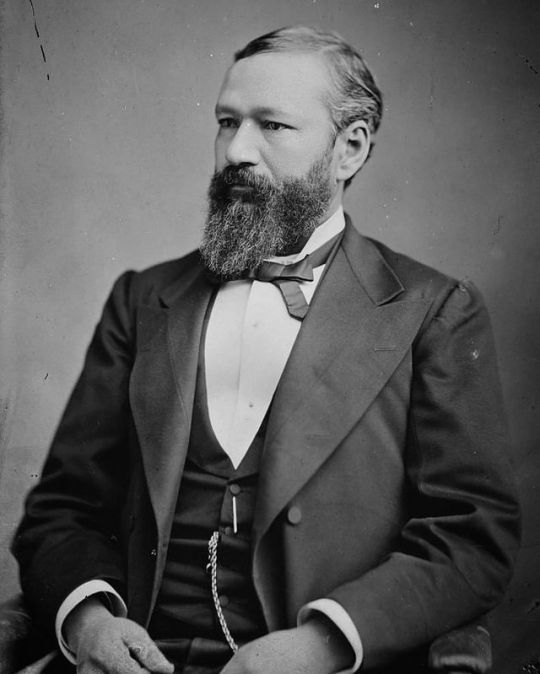
Today In History Pinckney Benton Steward (P.B.S.) Pinchback, the first Black state Governor (Louisiana), was born in Macon, GA, on this date May 10, 1837. | CARTER™️ Magazine carter-mag.com #wherehistoryandhiphopmeet #historyandhiphop365 #cartermagazine #carter #staywoke https://www.instagram.com/p/BxSTZDDAh4_/?igshid=1pbbl6q59j8f3
4 notes
·
View notes
Photo

Pinckney Benton Stewart Pinchback (born Pinckney Benton Stewart, May 10, 1837 – December 21, 1921) was a publisher and politician, a Union Army officer, and the first African American to become governor of a US state. A Republican, he served as the 24th Governor of LA from December 9, 1872, to January 13, 1873. He was one of the most prominent African-American officeholders during the Reconstruction Era. He traveled to Union-occupied New Orleans. There he raised several companies for the 1st LA Native Guard and became one of the few African Americans commissioned as officers in the Union Army. He remained in New Orleans after the Civil War, becoming active in Republican politics. He won election to LA State Senate in 1868 and became the president pro tempore of the state senate. He became the acting Lt Governor of LA upon the death of Oscar Dunn in 1871 and briefly served as Governor of LA after Henry C. Warmoth was suspended from office. He was the first African American to serve as a US governor. African Americans were increasingly disenfranchised in the South at the turn of the 20th century; he was the only African American to serve as governor of a US state until 1890. After the contested 1872 Louisiana gubernatorial election, Republican legislators elected Pinchback to the US Senate. Due to the controversy over the 1872 elections in the state, which were challenged by white Democrats, he was never seated in Congress. He served as a delegate to the 1879 LA constitutional convention, where he helped gain support for the founding of Southern University. In a Republican federal appointment, he served as the surveyor of US customs of New Orleans. He worked with other leading men of color to challenge the segregation of Louisiana's public transportation system, leading to the Supreme Court case of Plessy v. Ferguson. To escape increasing racial oppression, he moved with his family to DC, where they were among the elite people of color. #africanhistory365 #africanexcellence https://www.instagram.com/p/CdYDcutLmmQJ7F4zSzRhoRJCJy2odF00FQic1Y0/?igshid=NGJjMDIxMWI=
1 note
·
View note
Photo
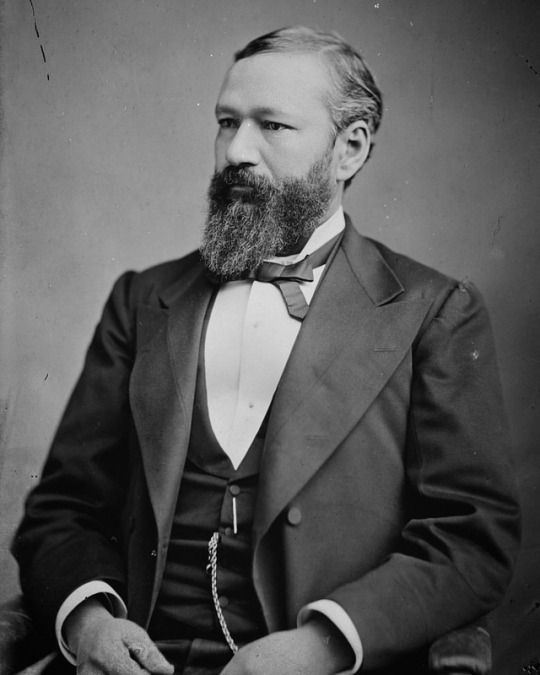
Today In History Pinckney Benton Steward (P.B.S.) Pinchback, the first Black state Governor (Louisiana), was born in Macon, GA, on this date May 10, 1837. | CARTER™️ Magazine carter-mag.com #wherehistoryandhiphopmeet #historyandhiphop365 #cartermagazine #carter #staywoke
8 notes
·
View notes
Photo

Pinckney Benton Stewart Pinchback (born Pinckney Benton Stewart, May 10, 1837 – December 21, 1921) was a publisher and politician, a Union Army officer, and the first African American to become governor of a US state. A Republican, he served as the 24th Governor of LA from December 9, 1872, to January 13, 1873. He was one of the most prominent African-American office holders during the Reconstruction Era. He traveled to Union-occupied New Orleans. There he raised several companies for the 1st LA Native Guard and became one of the few African Americans commissioned as officers in the Union Army. He remained in New Orleans after the Civil War, becoming active in Republican politics. He won election to LA State Senate in 1868 and became the president pro tempore of the state senate. He became the acting Lt Governor of LA upon the death of Oscar Dunn in 1871 and briefly served as Governor of LA after Henry C. Warmoth was suspended from office. He was the first African American to serve as a US governor. African Americans were increasingly disenfranchised in the South at the turn of the 20th century; he was the only African American to serve as governor of a US state until 1890. After the contested 1872 Louisiana gubernatorial election, Republican legislators elected Pinchback to the US Senate. Due to the controversy over the 1872 elections in the state, which were challenged by white Democrats, he was never seated in Congress. He served as a delegate to the 1879 LA constitutional convention, where he helped gain support for the founding of Southern University. In a Republican federal appointment, he served as the surveyor of US customs of New Orleans from. He worked with other leading men of color to challenge the segregation of Louisiana's public transportation system, leading to the Supreme Court case of Plessy v. Ferguson. To escape increasing racial oppression, he moved with his family to DC, where they were among the elite people of color. #africanhistory365 #africanexcellence https://www.instagram.com/p/COsq9y0LpfL0ngMl6sD4-ZzSpqxEfLGe3bE8Uk0/?igshid=xcq24bpqwj5e
0 notes
Photo
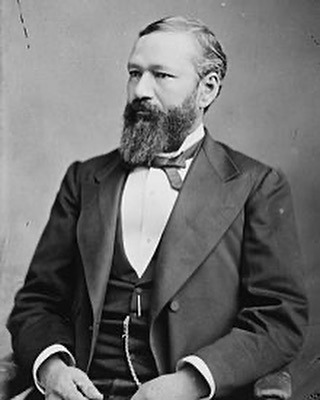
Pinckney Benton Stewart Pinchback (born Pinckney Benton Stewart, May 10, 1837 – December 21, 1921) was a publisher and politician, a Union Army officer, and the first African American to become governor of a US state. A Republican, Pinchback served as the 24th Governor of Louisiana from December 9, 1872, to January 13, 1873. He was one of the most prominent African-American officeholders during the Reconstruction Era. After the start of the American Civil War, Pinchback traveled to Union-occupied New Orleans. There he raised several companies for the 1st Louisiana Native Guard and became one of the few African Americans commissioned as officers in the Union Army. Pinchback remained in New Orleans after the Civil War, becoming active in Republican politics. He won election to the Louisiana State Senate in 1868 and became the president pro tempore of the state senate. He became the acting Lieutenant Governor of Louisiana upon the death of Oscar Dunn in 1871 and briefly served as Governor of Louisiana after Henry C. Warmoth was suspended from office. He was the first African American to serve as a US governor. African Americans were increasingly disenfranchised in the South at the turn of the 20th century. After the contested 1872 Louisiana gubernatorial election, Republican legislators elected Pinchback to the US Senate. Due to the controversy over the 1872 elections in the state, which were challenged by white Democrats, Pinchback was never seated in Congress. #africanhistory365 #africanexcellence #usarmy https://www.instagram.com/p/CABwT4_npSQS56XSP2XVudIbr0YwWz0N_mG4sU0/?igshid=1uq4kunsrfnm1
0 notes
Photo
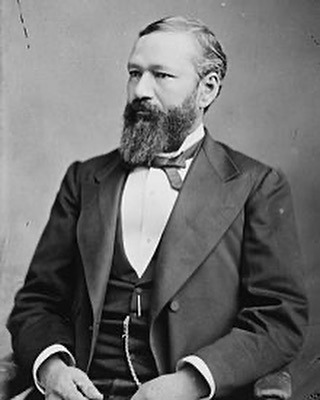
Pinckney Benton Stewart Pinchback (born Pinckney Benton Stewart, May 10, 1837 – December 21, 1921) was an American publisher and politician, a Union Army officer, and the first African American to become governor of a US state. A Republican, Pinchback served as the 24th Governor of LA from December 9, 1872, to January 13, 1873. He was one of the most prominent African-American officeholders during the Reconstruction Era. Pinchback traveled to Union-occupied New Orleans. There he raised several companies for the 1st LA Native Guard and became one of the few African Americans commissioned as officers in the Union Army. Pinchback remained in New Orleans after the Civil War, becoming active in Republican politics. He won election to LA State Senate in 1868 and became the president pro tempore of the state senate. He became the acting Lt Governor of LA upon the death of Oscar Dunn in 1871 and briefly served as Governor of LA after Henry C. Warmoth was suspended from office. He was the first African American to serve as a US governor. African Americans were increasingly disenfranchised in the South at the turn of the 20th century; Pinchback was the only African American to serve as governor of a US state until 1890. After the contested 1872 Louisiana gubernatorial election, Republican legislators elected Pinchback to the US Senate. Due to the controversy over the 1872 elections in the state, which were challenged by white Democrats, Pinchback was never seated in Congress. Pinchback served as a delegate to the 1879 LA constitutional convention, where he helped gain support for the founding of Southern University. In a Republican federal appointment, he served as the surveyor of US customs of New Orleans from 1882 to 1885. Later he worked with other leading men of color to challenge the segregation of Louisiana's public transportation system, leading to the Supreme Court case of Plessy v. Ferguson. To escape increasing racial oppression, he moved with his family to DC in 1892, where they were among the elite people of color. #africanhistory365 #africanexcellence #usarmy https://www.instagram.com/p/B5u8N5DHrRjYgstrApUoYtaoO15FPDEsSjijPw0/?igshid=apr4yi82qjdt
0 notes